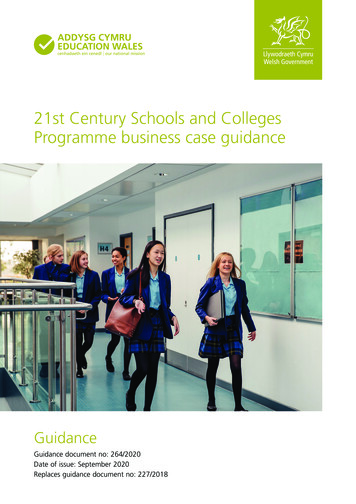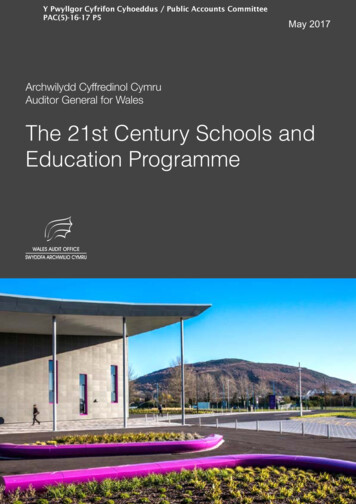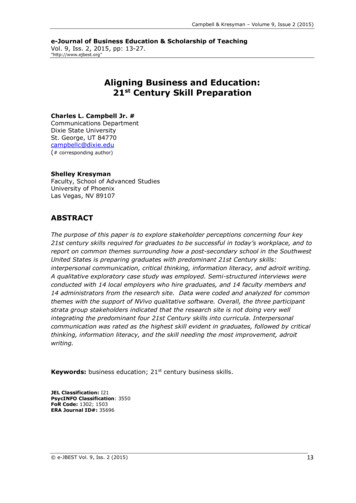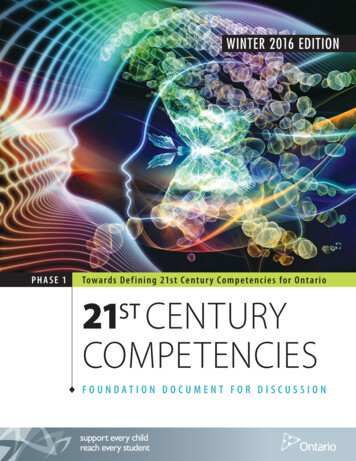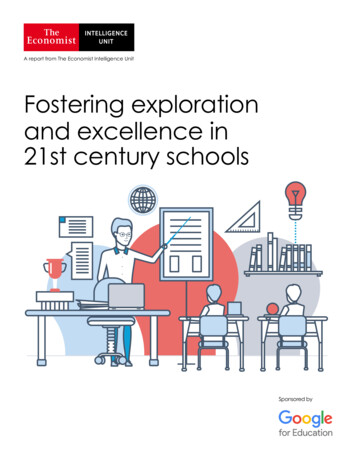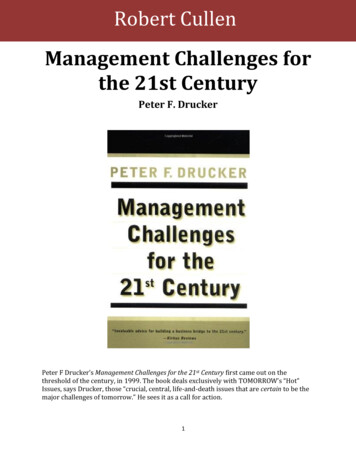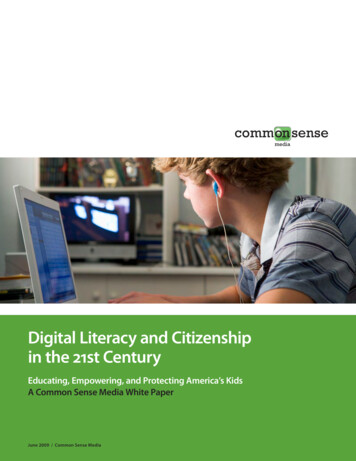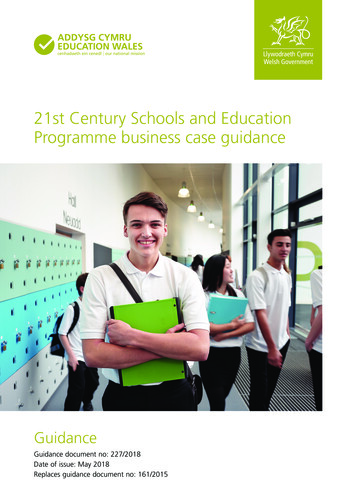
Transcription
21st Century Schools and EducationProgramme business case guidanceGuidanceGuidance document no: 227/2018Date of issue: May 2018Replaces guidance document no: 161/2015
21st Century Schools and Education Programmebusiness case guidanceAudienceThis guidance is aimed at local authorities, diocesan authorities, further educationinstitutions and higher education institutions.OverviewThe guidance and templates will assist those developing business cases forconsideration by the Education Directorate.Action requiredThe guidance should be used when preparing business cases for capital fundingfrom the 21st Century Schools and Education Programme.Further informationEnquiries about this document should be directed to:Education Business Planning and GovernanceThe Education DirectorateWelsh GovernmentCathays ParkCardiffCF10 3NQTel: 03000 257672e-mail: 21stcenturyschools@gov.wales@WG EducationFacebook/EducationWalesAdditional copiesThis document can be accessed from the Welsh Government’s website athttp://21stcenturyschools.org/?lang enRelated documents21st Century Schools and Education Funding Programme business caseguidance (2015)Guidance for community benefits (2018)Mae’r ddogfen yma hefyd ar gael yn Gymraeg.This document is also available in Welsh. Crown copyright 2018WG31696Digital ISBN 978 1 4734 9482 4
Contents1. Introduction22. Application process53. Assessment Process184. Project approval process195. Project monitoring and evaluation276. Band B30Annex 1: Strategic outline programme (SOP) revision template [not in document]Annex 2: Programme benefits table [not in document]Annex 3: Strategic outline case (SOC) template [not in document]Annex 4: Options framework – worked example (SOC stage) [not in document]Annex 5: Outline business case (OBC) template [not in document]Annex 6: Full business case (FBC) template [not in document]Annex 7: Business justification case (BJC) template [not in document]Annex 8: School project benefits table [not in document]Annex 9: Further education project benefits table [not in document]Annex 10: Options appraisal template (worked example) [not in document]Annex 11: Options appraisal template (blank) [not in document]Annex 12: Size and cost standard [not in document]Annex 13a: Project cost template [not in document]Annex 13b: Project information proforma [not in document]Annex 14: Community benefits – project information proforma (guidance and workedexample) [not in document]Annex 15: Closing report template and guidance [not in document]
1. Introduction1.1ContextThe 21st Century Schools and Education Programme is delivered by the Welsh Governmentin accordance with the Better Business Case Guidance.To be of assistance, Welsh Government has provided this guidance in support of thisprocess to illustrate the specific information requirements of the Education Directorate’s 21stCentury Schools and Education Programme’s Band A and Band B investments.This guidance should be read in conjunction with the Green Book and Public sectorbusiness cases using the five case model: update guidance which can be found on the HMTreasury website ok-appraisal-and-evaluation-in-centralgovernentHM Treasury is in the process of updating the Green Book. When the update is published,this guidance will be updated accordingly.1.221st Century Schools and Education Programme backgroundBand A of the 21st Century Schools and Education Programme represents a 1.4 billioninvestment over the five year period ending 2018/19. All 22 local authority areas will benefitfrom this major schools improvement programme, which will support the rebuild andrefurbishment of over 150 schools and colleges.The programme is 50% funded by Welsh Government using a combination of capital andrevenue funding, with the remaining 50% funding provided by local authorities and others.The primary aims of the programme are to: Reduce numbers of poor condition school buildingsReduce surplus capacityReduce running costs so as to maximise resources available to target improvementsto learner outcomesAddress specific demand for places in Welsh medium and Faith Based provision.All submitted Business Cases are underpinned by a Strategic Outline Programme (SOP),which provides an overarching view of individual local authority / further education institutionstrategies. Individual projects can then be approved subject to receipt of a satisfactoryBusiness Case.For projects over 5 million, Business Cases are submitted in three stages: Strategic Outline Case (SOC) Outline Business Case (OBC) Full Business Case (FBC)For smaller projects less than 5 million in value the SOC, OBC and FBC are replaced by asingle document, the Business Justification Case (BJC).2
1.3Changes to processFollowing feedback from our partners in local authorities and the further education sector,we want to reduce bureaucracy by streamlining the business case process.Therefore, the purpose of this document is to simplify the Business Case process and to actas guidance for the completion of Business Cases. To do this, we have created templatesthat include targeted questions and word counts.We operate on a principle of continuous improvement, and welcome your comments on thisguidance.1.4Process overviewAll Business Cases will be based on the five key areas that underpin the Better BusinessCase Process (Five Case Business Model).Strategic CaseHow does the proposal fit strategicallywith government/local priorities?What is the case for change and are thereclear SMART investment objectives?Economic CaseWhat are the options for delivering theinvestment objectives and which oneoptimises value for money?Commercial CaseHow can a deal be done with deliveryagents?What are the procurement strategy andthe commercial arrangements for theproposed investment?What is the Community Benefits plan?Financial CaseIs the proposal affordable?What are the sources of match fundingand what is the accounting treatment ofthe investment?Management CaseHow will the successful delivery of thescheme and whole life benefits bemanaged?These five areas are examined at each stage of the Business Case process, with greaterdetail being available at each stage of development.3
The SOC will focus on the strategic justification (Strategic Case), investmentobjectives for the project (Strategic Case), the reasoning behind reduction of the longlist to a short list of options (Economic Case) and the proposed managementstructure (Management Case). The OBC will focus on the commercial strategy (Commercial Case), the detailedanalysis of the shortlisted options (Economic Case), details of match funding andprofile of spend (Financial Case). Any changes to the strategic justification or anyadditional options considered should also be included. The FBC will focus on finalised management structure (Management Case),monitoring and evaluation of benefits (Management Case) and the agreed contract(Commercial Case). For smaller projects, the BJC covers all of these areas in a single iteration.In certain situations, it may be possible to combine Business Cases, and submit a jointSOC/OBC or a joint OBC/FBC. This is appropriate for Business Cases that are relativelystraightforward (i.e. not contentious, like for like replacements etc.) or lower valueinvestments (generally less than 10 million).If you wish to combine your Business Case submission, please speak to the appropriatecontact (see 2.2), who will be able to advise you on whether a joint SOC/OBC or OBC/FBCis appropriate.4
2. Application process2.1BackgroundBusiness Cases map to the stages of development of your project and provide break pointsthat enable key decisions to be made.Because of the different decisions being made at each stage, different levels of informationare required to support the case.To reflect the different information requirements, forms have been created that ask keyquestions that will allow us to gather the appropriate information for each stage of theprocess.All relevant information should be contained in the body of the document. With theexception of the Option Appraisal Template, which is to be attached as an appendix, anyother annexes / appendices will be disregarded. Business Cases should also be pagenumbered.2.2Strategic Outline Programme (SOP)SOPs have been devised to assist the development and agreement of programmes insupport of an agreed strategy/strategies. This document captures the purpose of theinvestment at a strategic level.Although this Guidance predominantly deals with SOC, OBC and FBC, there may beoccasions where it is necessary to amend your SOP to reflect a change in direction or anidentified need for an increase or decrease in resources.The process for such a change is as follows: Raise the issue with the appropriate Welsh Government contact:o Programme Directoro Head of Capital Fundingo Head of School Reorganisationo School Reorganisation Manager Submit a form that explains the purpose for the change and the implication toobjectives, options and funding. This will then be assessed by the Welsh Government’s Capital Investment Panel andany recommendation for approval considered by the Cabinet Secretary for EducationPlease note that any requests for change to a Programme Envelope will require submissionof a revised SOP, which is assessed by the Business Case Scrutiny Group and CapitalInvestment Panel before consideration by the Cabinet Secretary.Please refer to Annex 1: SOP Revision Template.You will also be required to complete a Programme Benefits Table (see Annex 2) toidentify the current position and the impact that your different options will have.5
2.3Strategic Outline Case (SOC)At an early stage, the main purpose of the SOC is to: establish the need for investmentappraise the main options for service deliveryprovide a recommended or preferred way forward for further analysisprepare and appraise the long list of options within the economic caserecommend a preferred way forward, together with indicative costs, for moredetailed analysis within the OBC.In practice, this entails building on local and governmental strategy documents to make thecase for change within the strategic case. For example, alignment with: The Wellbeing of Future Generations (Wales) Act 2015Taking Wales ForwardWelsh language policyQualified for Life30 hour childcare offerInfant class size capital grantWelsh in Education Strategic Plans (WESP) – it is really important that yourplans align with the WESP for your area. Please highlight how you will meetlocal needs for Welsh medium provision/ expand/ move along the continuum.Local Development PlansPupil numbersBusiness planning is an iterative exercise, so bear in mind the need to revisit earlierassumptions. Also note that the SOC should be prepared in accordance with best practiceguidance provided in HM Treasury’s Green Book.2.3.1. Executive summaryThis should be a concise summary of your findings. It should cover the following: What do you want to do?Why do you need to do it?What will it achieve in terms of benefits to condition, capacity and learners?What is the estimated cost?It should also contain a summary of the information contained within each of the fivecases.How will the project comply or conflict with other government/local priorities?2.3.2 Strategic caseThis is one of the most important components of this document and should clearly identifythe following: Strategic FitCase for changePlease refer to Annex 3: SOC Template for full list of questions to be addressed underStrategic Fit and Case for Change.6
2.3.3 Economic caseThe Economic Case draws heavily from HM Treasury’s Green Book referenced in theopening paragraphs of this guidance. HM Treasury is in the process of updating the GreenBook. When the Green Book update is published, this guidance will be amended asappropriate.At each stage of the business case process, you will be required to complete a School orFurther Education Benefits Table (see Annexes 8 and 9) to identify the current positionand the impact that your different options will have.The purpose of the Economic Case at the SOC stage is to identify your long list of optionsand reduce it down to a short list.To do this, it is important to identify the critical success factors. These might typicallyinclude: Do the short-listed options fit with local / national strategies?Do they provide good value for money?Are the options deliverable?Are the options achievable in the timeframe?Are the options affordable?Are the options socially/politically acceptable?Do they provide better outcomes for learners?Do they enable resources/facilities such as sports facilities and pitches to be used bythe local community thereby helping to improve sustainability?Do they support different styles of teaching and learning?Do they support pupil wellbeing and provide better outcomes for learners?Each option should be assessed against both the investment objectives and critical successfactors and carried forward or discounted as appropriate. The Value for Money assessmentshould consider, in so far as possible, on-going operational costs such as the requirementto provide free transport to pupils on grounds of distance or lack of safe walking routes.It is useful to address these questions in a workshop. Attendees should represent thegroups affected by the project, as well as members of the project team. It is important thatyou note who attended the workshop held to generate the long list of options and recordwhen the workshop was held.As a minimum, each option should include: a brief description of the option;a recording of each option’s advantages and disadvantages;a recording on the conclusion reached in respect of the option;the reasoning behind any decision made, particularly when an option is discounted.In terms of the generation and analysis of your long list of options, the options frameworkenables consideration of a wide range of options and provides a methodology to develop ashort list of options for further analysis at OBC. The short list of options should alwaysinclude a ‘status quo’/do minimum’ option.7
The options framework comprises: Scope (coverage: who, what, where etc.)Service Solution (how: technical)Service Delivery (who: provider)Implementation (when: phasing & time)Funding (how: )Please refer to Annex 4: Options Framework – Worked ExampleAt this point, a brief analysis should be undertaken around the indicative economic costs ofthe shortlisted options; remember to adopt a proportionate approach and make allowancesfor optimism bias.This work should enable identification of a preferred way forward at this time, subject tomore detailed analysis in the OBC.2.3.4 Commercial caseAt this stage, it is only necessary to identify your proposed procurement route, e.g. use of aregional framework such as SEWSCAP, South West Wales Regional Contractor Framework(SWWRCF) or North Wales Schools and Public Buildings Contractor Framework or via aseparate OJEU Procurement route.Reference should be made to: the inclusion of Community Benefits and, if known, whether they will be core and/ornon core to the contract;the specific Community Benefit objectives and confirmation the project will captureresults via the Community Benefits measurement tool;a statement on how clients will promote sub-contract supply of Welsh or UK suppliedsteel on projects where steel is a major component;consideration of the Better Jobs Closer to Home objectives pertaining to jobopportunities for those from areas of high deprivation and joblessness in Wales.2.3.5 Financial caseAt this stage only limited information is needed. You should: identify the estimated cost of the preferred way forward broken down over financialyearsidentify how this will be funded.For example: “The preferred way forward will cost an estimated 10 million, which is 50%funded by the Welsh Government. The remaining 50% will be via 1 million CapitalReceipts, which are already realised, 2.3 million local authority capital funding and 1.7million borrowing.” It is important that any match funding secured is identified, and that anyuncertainty or assumptions around the remaining match funding is captured here.Is the project part of batch procurement? If not, what consideration has been given to thisapproach? Has the financial loss of not adopting this approach been assessed?8
Please note Welsh Government area and cost formulas are to be applied. Please refer toAnnex 12: Cost and Size Standard. Sound evidence will need to be provided shouldproject areas and costs be higher than these applied formulas.2.3.6 Management caseThis should explain the governance of the scheme and how it is an integral part of the localauthority/further education institution 21st Century Schools and Education Programme. Itshould also explain how the project will be managed within the local authority/furthereducation institution, the resources required and the risks to delivering the projects and howthey will be managed.For example:“The following arrangements will be put in place to ensure the successful development ofthe scheme and production of the OBC.The project will be managed in accordance with Prince2 methodology.Any assurance e.g. Gateway Review, which has been undertaken on the programme, inconjunction with agreement to the SOP. The consequent actions are as follows TheMilestone activities are as follows .”It would be useful to also include references to early plans/proposals for benefits realisationor evaluation.2.4Outline Business Case (OBC)The main purpose of the OBC is to: revisit the case for change and the preferred way forward identified in the SOCestablish the option which optimises value for moneyoutline the deal and assess affordabilitydemonstrate that the proposed scheme is deliverable.In practice, this entails: updating the strategic case if appropriateundertaking investment appraisal within the economic casecompleting the commercial, financial and management cases, with supportingbenefits and risk registers.Sign off of the OBC provides agreement that a tender process can now take place.By OBC stage, you will have already undertaken site investigation and incurred design andmanagement costs.At the point that your OBC is signed off, you will be entitled to claim for eligible costsincurred to date.For full list of what to include within the OBC, please refer to Annex 5: OBC Template2.4.1 Executive summaryThis should be a concise summary of the proposal.9
2.4.2 Strategic caseAt OBC stage it may be necessary to update the Strategic Case as presented at SOC.2.4.3 Economic caseAt OBC stage it is vital that a convincing and comprehensive Economic Case is provided.At each stage of the business case process, you will be required to complete a School orFurther Education Benefits Table (see Annexes 8 and 9) to identify the current positionand the impact that your different options will have.Short-listed optionsRestate the shortlisted options as identified in the SOC. Any changes should be highlighted.The economic appraisal should provide an overview of the main costs and benefitsassociated with the shortlisted options. This will be supported by the detailed financialanalysis (please see Annex 10: Options Appraisal Template – worked example andAnnex 11: Options Appraisal Template – blank)Information around costs and exclusions are included in the HM Treasury Green BookGuidance on Options Appraisals. The economic analysis focusses on value for money andshould: use constant (base year) pricesinclude opportunity costsinclude all quantifiable costs, benefits and risks to both organisation and widersocietyinclude environmental costs; make allowances for optimism biasexclude all Exchequer ‘transfer’ payments – for example, VATexclude general inflationexclude sunk costsexclude depreciation and capital charges.A new build school or college should be assessed over a sixty year period. Refurbishmentof a school or college should be assessed over a thirty year period.As well as the quantifiable costs and benefits, an analysis of qualitative benefits should alsobe included. This should be undertaken by identifying the benefits criteria relating to each ofthe investment objectives. The method used is as follows: weight the relative importance (in %) of each benefit criterion in relation to eachinvestment objectivescore each of the short-listed options against the benefit criteria on a scale of 0 to 9derive a weighted benefits score for each option.The results of this analysis should also be summarised together with the reasoning behindthe weighting and scoring of benefits. Aim to include independent participants in theanalysis to ensure that decisions are as objective as possible and not biased by apreference for a particular solution.While the assessment of qualitative benefits is important, it is critical that the quantitative(essentially NPV or NPC results) and qualitative (weighting and scoring) analyses“complement each other” (Green Book, page 38). If they suggest different options should10
be pursued, then the Green Book suggests further analysis is undertaken before thepreferred option is identified.Benefit Criteria andWeightOption 1Option 2Option 3Option 4Raw (R) and weighted(W)scoresRRRRWWWWBenefit Criteria 1Benefit Criteria 2Benefit Criteria 3Benefit Criteria 4Benefit Criteria 5TotalRankRisk appraisal – Qualitative (unquantifiable)The risks associated with the scheme must be identified, prioritised and appraised in allinstances.In the case of significant, new and/or high value investments, the risks should be quantifiedin s and included in the economic appraisals (‘cost of risk retained’). In the absence of riskmeasurement (in s), a sum should be included for optimism bias. All other risks: those thatare unquantifiable in s, should be appraised as shown below.In the case of medium and small sized schemes, it may suffice at this stage to weight andscore the risks for each option and to rank accordingly, see below.Whatever the approach, a sum must be included for optimism bias in the economicappraisals.Ideally, the risks should be quantified (in s) in all cases and the unquantifiable risksassessed as outlined below. In most instances, you will find the service risks associatedwith the design, build and operation features of the scheme fall in the former category, whileassociated business risks fall into the latter. External environmental risks, for example,inflation, may be ignored for the purposes of this appraisal, given that they are common toall options.Risks in respect of each of the options should be recorded and scored.Following the three elements of analysis: Economic, Benefits and Risk, a summary tableshould be produced.Evaluation ResultsOption 1Option 2Economicappraisals11Option 3Option 4
Benefits appraisalRisk appraisalOverall RankingThe conclusion should then be reached that the preferred option is ‘X’ and provide reasons.Sensitivity analysisIt is important that the sensitivity of the preferred option is tested through: ‘switching values’ scenario planning / analysis (‘what if’) by altering the values of the ‘uncertain’ costsand benefits to observe the effect on the overall ranking of options.The results of this testing should be recorded in the OBC and whether this has changed thepreferred option ranking.2.4.4 Commercial CaseThis section of the OBC outlines the proposed deal in relation to the preferred optionoutlined in the economic case.2.4.5 Financial caseThe purpose of this section is to set out the financial implications of the preferred option byfinancial year (as set out in the economic case section) and the proposed deal (asdescribed in the commercial case).As the Welsh Government is paying for 50% of the project, it is important that we areconfident that the remaining 50% of the project is affordable. Welsh Governmentcontribution will be capped and local authorities and further education institutions will beexpected to deliver within this budget.At this point in the project development, local authorities and further education institutionsshould identify the sources of match funding and confirm that these are signed up to by therelevant parties in the local authority / further education institution.For example:Capital Receipts: Have these been received? Are they ring fenced for the project? If theasset is not yet sold, what is the basis of valuation? When will the money from the sale bereceived? Will the timing of any sale impact on the project cash flow?Capital Funding: Has this been signed up to by the Cabinet / Board? If so, when was thismeeting? If not, when will this proposal go before the Cabinet / Board for sign up? Includeminute details.Prudential / Other Borrowing: Has the borrowing been secured? Has a revenue streambeen identified to fund the borrowing? Has a sensitivity analysis been carried out to ensurethat the borrowing is affordable if any circumstances change?12
Savings achieved through school reorganisation: Have the relevant consultations beenundertaken to achieve the proposed reorganisation? Has the Cabinet/Board confirmed thatthey are happy to ring fence this released revenue for the purpose of funding the project? Ifso, on what date was this confirmed?Will the project generate revenue costs or savings?In all cases, capital charges, VAT, and the cost of risk (any contingency or allowance for riskadjustment and optimism bias) should be shown separately. For Voluntary Aided andfurther education institutions, there are VAT implications for capital investment and HMRCguidance should be sought to ensure that the full cost of the project is reflected in theapplication.You will need to detail the cash-flow showing the impact of the capital spend, revenuesavings and any interest repayments.It should also be made clear who the created asset belongs to. For example, will it sit onthe Balance Sheet of the local authority or another party?2.4.6 Management CaseThis section of the OBC addresses the ‘achievability’ of the scheme. Its purpose, therefore,is to build on the SOC by setting out in more detail the actions that will be required to ensurethe successful delivery of the scheme in accordance with best practice.This section should include confirmation that the project will be managed in accordance withPRINCE 2 methodology, details of the reporting organisation and structure for the project,details of project roles and responsibilities, and an overview of the project plan withmilestones. This should explain the governance, project management and resources pre,during and after procurement.The description of the project structure should include a structure chart for assessors tobetter understand roles and reporting lines.It is also important that this case provides the outline arrangements for contractmanagement; benefits realisation, risk management and monitoring and evaluation.It should also provide details of land ownership, statutory consultation and outline planning.The Gateway Review Process should also be referenced, along with confirmation that anyrecommendations are actioned.2.5Full Business Case (FBC)The FBC is submitted following procurements, but prior to contract signature.The main purpose of the FBC is to evidence that the most economically advantageous offerwhich matches the strategic case or preferred option is being procured and that it isaffordable and deliverable. In addition, the FBC explains the fundamentals of thenegotiated deal and demonstrates that the required outputs can be successfully achieved.In practice, this entails:13
reviewing the strategic and economic cases and updating details in the Commercialcase to reflect the procurement phase completing the Commercial Case to record the preferred service provider’s offerings updating any changes to the Financial Case and putting in place robust governanceand management arrangements for delivery of the project and resources confirming that costs have not changed since OBC stage and that the parties payingfor the scheme have confirmed that risk transfer remains the same.2.5.1 Executive SummaryThis should be a concise summary of the proposal and be updated to include the finalisedposition.2.5.2 Strategic CasePlease refer back to the SOP, SOC and OBC, noting any key changes since the productionand approval of these documents.2.5.3 Economic CaseAs this section has been covered in detail at OBC stage, there is no need to restate thecase in detail, although highlight any important changes and consider whether or not thechanges might materially impact upon the ranking of the options achieved at OBC, andrecord your conclusions.At each stage of the business case process, you will be required to complete a School orFurther Education Benefits Table (see Annexes 8 and 9) to identify the current positionand the impact that your different options will have.2.5.4 Commercial CaseThis section of the FBC sets out the negotiated arrangements and includes a description ofthe required services and risk transfer agreements.2.5.5 Financial CaseThe purpose of this section is to set out firm financial implications of the contracted solution.This should contain finalised financial arrangements. As the Welsh Government is payingfor 50% of the project, it is important that we are confident that the remaining 50% of theproject is affordable. This case should therefore confirm the sources of match funding. Forexample: Capital Receipts: Confirmation that these have been received and ring fenced for thepurpose of the project. For any receipts not realised, assurance should be madearound the timing an amount of the receipt. Capital Funding: Evidence of commitment by the Cabinet / Board should be provided. Prudential / Other Borrowing: Evidence that borrowing is secured and a revenuestream identified to cover repayments should be provided. Savings achieved throug
2 1. Introduction 1.1 Context The 21st Century Schools and Education Programme is delivered by the Welsh Government in accordance with the Better Business Case Guidance. To be of assistance, Welsh Government has provided this guidance in support of this


